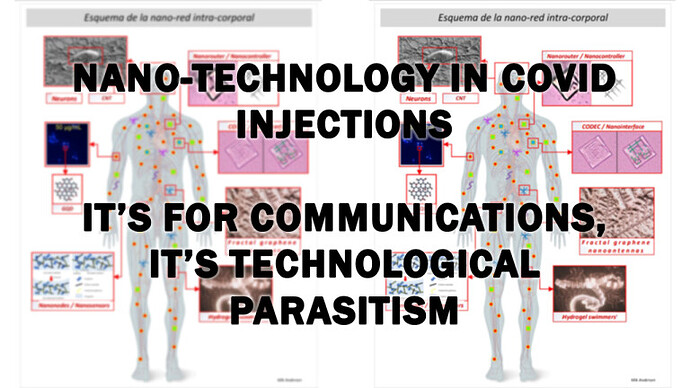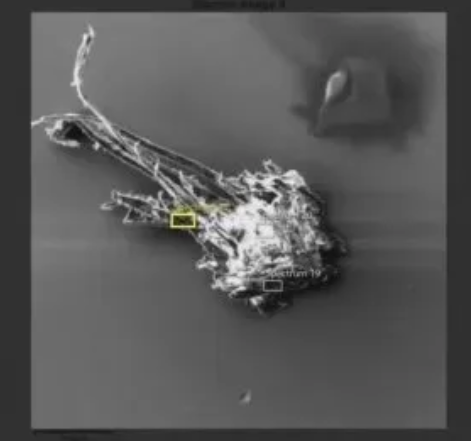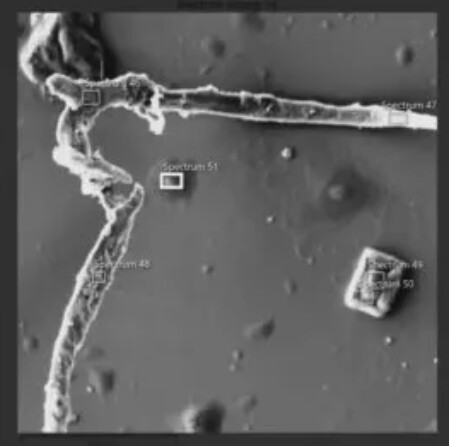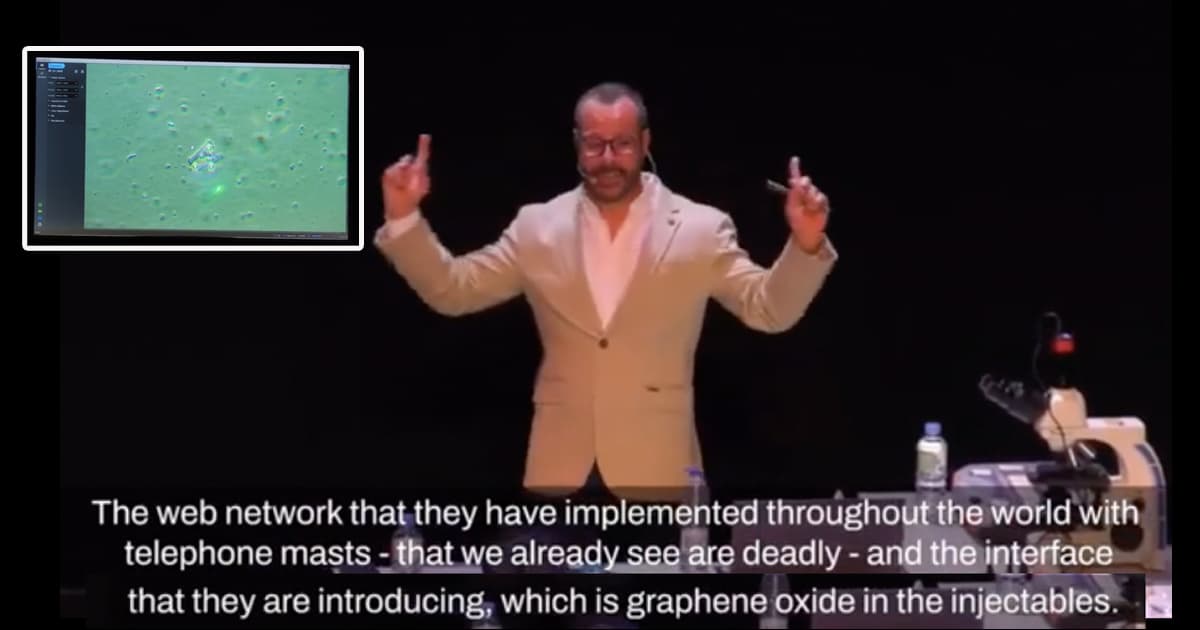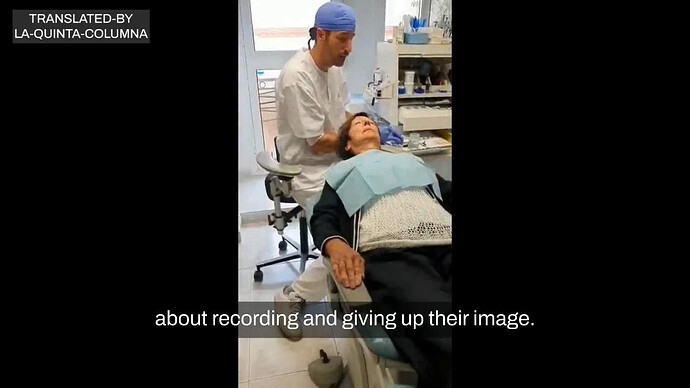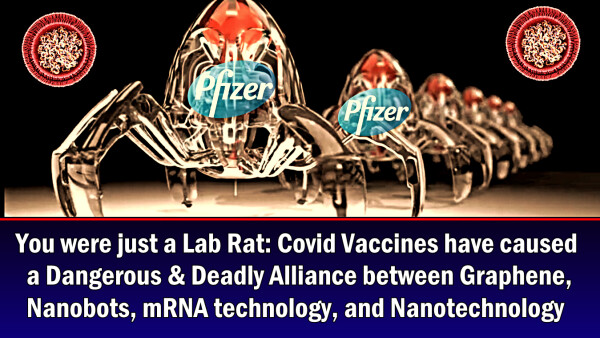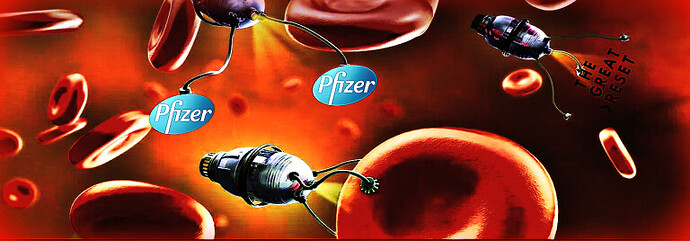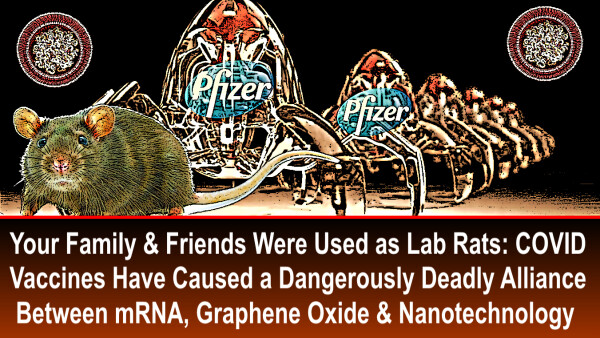How to remove the Nanobots, Nanotech & Graphene found in the COVID Injections being transmitted from the Vaccinated from your body
By The Exposé on May 24, 2023
In an era marked by the infiltration of graphene nanomaterials/nanobots into various aspects of our lives, concerns over their potential health implications have grown. The inadvertent exposure to graphene and its potential accumulation in the body has raised questions about how to effectively remove this powerful material.
From their ability to manipulate biological processes and disrupt normal physiological functions to their potential for widespread transmission and long-term health consequences, the implications are deeply unsettling.
Sadly, one doctor has already proven that Graphene Nanobots are within the mRNA Covid-19 injections. But what’s even more upsetting, is that he has also concluded that they are being transmitted from the vaccinated to the unvaccinated, destroying red blood cells and forming strange and rare blood clots.
So as the prevalence of graphene nanomaterials continues to increase, understanding how to safely remove them from the body becomes crucial. Thankfully, there are already several known ways to do so.
The Enigma of Graphene NanoBots:
Hidden within the depths of COVID-19 vaccines, an enigma awaits discovery: graphene nanobots. These microscopic entities, composed of graphene oxide, possess a dark agenda that threatens human health and autonomy.
In the vast landscape of scientific advancements, one enigma stands out: graphene nanobots. These microscopic entities, crafted from the extraordinary material known as graphene, have captivated the imaginations of researchers and innovators worldwide. Yet, behind their seemingly miraculous potential lies a disturbing and ominous reality—one that could shape the future of humanity in unforeseen and treacherous ways.
Graphene, a single layer of carbon atoms arranged in a two-dimensional lattice, possesses remarkable properties that have paved the way for revolutionary breakthroughs in various fields. Its strength, flexibility, and conductivity make it a coveted material for applications ranging from electronics to medicine. However, the integration of graphene into nanobots takes this technological marvel to a whole new level.
These minuscule robots, driven by the power of nanotechnology, possess the ability to navigate the intricate terrain of our bodies with unprecedented precision. Their potential applications appear endless: targeted drug delivery, tissue repair, disease detection, and even neural interfaces. But as with any profound technological advancement, questions arise about the potential risks and unintended consequences that may accompany these seemingly remarkable creations.
One concerning aspect of graphene nanobots lies in their potential for infiltration and manipulation. As they navigate through our bloodstream, these microscopic agents have the capacity to interact with our cells, tissues, and even our DNA. The prospect of intentional manipulation or unintended side effects raises alarms about the invasion of our bodily autonomy and the potential for irreversible harm.
Furthermore, the implications of the widespread deployment and utilization of graphene nanobots in society are shrouded in ambiguity. The possibility of surreptitious surveillance, tracking, or alteration of our physical and cognitive functions becomes a disconcerting reality. As these nanobots become more integrated into our daily lives, the line between human agency and technological control blurs, giving rise to a dystopian world where our very essence is manipulated and exploited.
The enigma of graphene nanobots deepens as questions emerge about who holds the power to create and control these microscopic entities. Are they solely in the hands of benevolent scientists and innovators striving for the betterment of humanity?
Or do hidden agendas lurk behind closed doors, driven by the thirst for control and domination? Unravelling this mystery requires a critical examination of the forces at play and the underlying power dynamics that shape the development and deployment of graphene nanobots.
In our pursuit of scientific progress, we must tread cautiously and ethically. Transparency, accountability, and open dialogue become crucial to ensure that the potential dangers of graphene nanobots are acknowledged, addressed, and mitigated. Safeguards must be implemented to protect individual rights, privacy, and bodily autonomy in a world increasingly entwined with advanced technologies.
As we navigate the enigma of graphene nanobots, we must remain vigilant, questioning the motives and consequences of their existence. In the pursuit of a better future, we must weigh the benefits against the potential risks and tread the path of progress with wisdom and discernment.
Sources:
- Li, X., et al. (2020). Graphene-based nanobots for biomedical applications: A review. Nanoscale, 12(18), 9708-9720.
- Rajendran, V. (2021). Ethical Implications of Nanotechnology and Its Applications. Frontiers in Nanotechnology, 2, 631984.
- Chen, X., et al. (2021). Recent Advances in Graphene-Based Nanobots for Biomedical Applications. Small, 17(9), 2005497.
- Liu, Y., et al. (2020). Design Strategies and Applications of Graphene-Based Nanomaterials for Biomedical Applications. Small Methods, 4(5), 1900817.
Unmasking the Silent Destroyers:
As our investigation intensifies, startling evidence emerges, linking graphene nanobots to a range of nightmarish consequences.
But how does graphene end up in COVID-19 vaccines in the first place?
It is through the secretive manufacturing process, shrouded in layers of deception.
The confirmation can be found in a document submitted to the FDA by Pfizer to gain Emergency Use Authorization (EUA). A document that the FDA did not want to release for a minimum of 75 years, but were thankfully forced to by a federal judge.
The document confirms it is perfectly possible for toxic Graphene Oxide to end up in the Covid-19 vaccines due to the manufacturing process.
A full breakdown of the document can be viewed here.
But the document in question confirms it is perfectly possible for toxic Graphene Oxide to end up in the Covid-19 vaccines due to the manufacturing process.
In early January 2022, Federal Judge Mark Pittman ordered the FDA to release 55,000 pages per month of documents submitted by Pfizer, and since then, PHMPT has posted all of the documents on its website as they have been published.
Sadly, one of the most recent documents published by the FDA, saved as 125742_S1_M4_4.2.1 vr vtr 10741.pdf, confirms the use of Graphene Oxide in the manufacturing process of the Pfizer Covid-19 vaccine. Proving that medicine regulators the mainstream media, Fact Checkers and Pfizer have all been lying to you.
The document is a description of a study carried out by Pfizer between April 7th 2020 and 19th August 2020, with the objective being “to express and characterize the vaccine antigen encoded by BNT162b2.”
In layman’s terms, the study was conducted to determine how the vaccine works. The study found that the vaccine used mRNA to instruct your cells to produce a protein (called P2 S), which is the Spike protein of the alleged Covd-19 virus.
The millions of spike proteins then bind to a receptor called ACE2 on the surface of your cells, inducing an immune system response.
But what is most concerning about the study is the confirmation on page 7 that Graphene Oxide is required to manufacture the Pfizer Covid-19 vaccine.
Pfizer states on page 7 of the study in section 3.4 the following –

Source – Page 7
Therefore, during the manufacturing process, several factors could potentially introduce contaminants or foreign materials into the vaccine. This obviously includes the possibility of varying amounts of Graphene Oxide (GO) entering the final product.
In their relentless pursuit of control, the establishment has hidden the truth from the public. They have concealed the presence of graphene, a material with potentially grave implications, within the vaccine formulations.
This deliberate act of deception highlights the lengths to which the establishment will go to push its agenda while suppressing vital information that could threaten its power.
In the vast realm of scientific innovation, a silent menace lurks in the shadows: graphene nanobots. These inconspicuous agents, forged from the incredible material known as graphene, possess an insidious power that can wreak havoc on our very existence. As the world marvels at the promises of this revolutionary technology, it is imperative that we unmask the true nature of these microscopic entities and confront the chilling implications they hold for humanity.
Graphene, with its exceptional properties and incredible strength, has captivated the scientific community. But when this formidable material is harnessed to create nanobots, a sinister undercurrent emerges. These nanoscale machines, driven by the power of graphene, have the potential to infiltrate our bodies undetected, becoming a silent army of destroyers.
Once inside, graphene nanobots can unleash a cascade of devastation. They possess the ability to interact with our cells, tissues, and even our genetic makeup, effectively becoming malicious intruders within our very being. These tiny assassins can wreak havoc on our biological systems, causing unprecedented damage and irreparable harm.
One of the most horrifying aspects of graphene nanobots is their ability to manipulate and control our bodily functions. Imagine a scenario where these insidious agents override our natural systems, dictating our thoughts, emotions, and physical actions. Our autonomy is stripped away, we become mere puppets in the hands of these malevolent forces. The prospect of a dystopian world where our every move is orchestrated by these silent destroyers is a chilling thought indeed.
The ramifications of the widespread deployment of graphene nanobots extend far beyond individual autonomy. These microscopic entities can be programmed to carry out nefarious agendas, serving as covert agents of surveillance, control, and even annihilation. The potential for their misuse in the hands of those seeking power and domination is a terrifying reality that must not be ignored.
The manufacturing process of these graphene nanobots also raises profound concerns. Are these minuscule machines being injected into our bodies without our knowledge or consent? Is the public being misled about the true nature and purpose of these technological marvels? The veil of secrecy surrounding their production and distribution demands urgent scrutiny and demands transparency from the entities responsible for their creation.
As we peer into the abyss of graphene nanobots, it becomes clear that their emergence heralds a new era of profound existential threats. The dark underbelly of technological progress reveals itself, casting a shadow over the future of humanity. The power to manipulate, control, and destroy lies within the invisible hands of these microscopic foes, and it is up to us to rise and confront this terrifying reality.
Sources:
- Chen, J., et al. (2021). Graphene-based nanobots for biomedical applications: From targeted drug delivery to cancer therapy. Nano Today, 38, 101148.
- Zhang, Z., et al. (2020). Graphene-Based Nanobots: Theoretical Design and Fabrication. Frontiers in Robotics and AI, 7, 126.
- Kostarelos, K., et al. (2017). Graphene-based materials for biomedical applications. Angewandte Chemie International Edition, 56(33), 8745-8760.
- Vabbina, P. K., et al. (2021). Graphene-based nanobots: A review. TrAC Trends in Analytical Chemistry, 141, 116268.
The Alarming Discoveries:
Renowned nanotechnology expert, Dr. Philippe van Welbergen, has made groundbreaking strides in uncovering the truth about graphene nanoparticles and their potential presence in COVID-19 vaccines.
Through meticulous analysis of vaccine samples, Dr. van Welbergen has detected disturbing indications of graphene’s involvement, raising concerns about its impact on human health.
His findings correlate the presence of graphene with the emergence of perplexing blood clotting disorders and the destruction of essential red blood cells. These revelations demand urgent attention and further investigation into the safety and long-term consequences of graphene-containing injections.
Below is an image of typical healthy red blood cells as seen with a microscope, what blood should look like. There is no coagulation or foreign objects in it.

Strange Blood Clots and Vascular Disturbances: One of the alarming discoveries surrounding graphene nanobots is their association with the formation of unusual blood clots and vascular disturbances.
Scientific investigations have revealed that these tiny agents, when introduced into the bloodstream, have the capacity to trigger abnormal clotting mechanisms, leading to potentially life-threatening complications.
The interaction between graphene and blood components can disrupt normal coagulation processes, jeopardizing cardiovascular health and increasing the risk of strokes, heart attacks, and other vascular disorders.
THe following is of a person who has been injected with the experimental Covid vaccine.
The blood is coagulated, and the misshapen red blood cells are clumped together. The cell encircled in the image is a healthy red blood cell, one of the few in the image, sitting alongside the graphene fibres.
You can see the size of the graphene fibres in relation to the size of a red blood cell. Fibres of this size will block capillaries. You can also see the graphene fibres are hollow and contain red blood cells.

Destruction of Red Blood Cells: Further research has uncovered the distressing capability of graphene nanobots to destroy red blood cells.
These vital carriers of oxygen are essential for maintaining overall health and well-being. However, when exposed to graphene nanobots, red blood cells may undergo significant damage, impairing their ability to transport oxygen efficiently.
This disruption can have far-reaching consequences, ranging from reduced energy levels and impaired cognitive function to compromised organ health and diminished overall vitality.
Transmission from the Vaccinated to the Unvaccinated: Recent studies have also raised concerns about the potential transmission of graphene nanobots from vaccinated individuals to the unvaccinated population.
While the primary purpose of vaccination is to confer protection against specific diseases, there have been unsettling reports suggesting that graphene nanobots, used in some vaccine manufacturing processes, could be inadvertently transmitted to individuals who have not received the vaccine.
This raises profound ethical questions about the dissemination of untested and potentially harmful nanomaterials within the population.
The image below is of a blood sample from a vaccine-free, or unvaccinated, three-year-old child. It shows pieces or “shards” of graphene that “are the result of shedding,” in other words the graphene has been transmitted from “vaccinated” parents to their unvaccinated child.

Below is the image of a blood sample from an eight-year-old unvaccinated child whose blood has been contaminated and destroyed by the transmission of graphene from those around him/her who have had a Covid injection. The child’s right arm and upper right leg are basically paralysed, the child is unable to lift his/her right arm and the thigh is not functioning properly.

The Elusive Dystopian Future: These alarming discoveries bring us face-to-face with the potential dystopian future that could unfold if the sinister capabilities of graphene nanobots go unchecked.
From their ability to manipulate biological processes and disrupt normal physiological functions to their potential for widespread transmission and long-term health consequences, the implications are deeply unsettling.
The unintended consequences of unregulated and inadequately tested nanotechnology could pave the way for a future where our bodies and well-being are subject to manipulation by unseen forces.
Sources:
- Zhang, Y., Ali, S. F., & Dervishi, E. (2021). Graphene-based nanomaterials and their potential toxicological effects: A review. Environmental Science: Nano, 8(3), 596-614.
- Moein, M. M., Nejati-Koshki, K., & Akbarzadeh, A. (2021). Graphene oxide: A unique material for drug delivery applications. Nanotechnology Reviews, 10(1),
- Doctors find Graphene is shedding from the COVID Vaccinated to the Unvaccinated, forming Blood Clots & decimating Blood Cells - The Expose
The Troubling Phenomenon of Graphene Transmission:
As the investigation unfolds, an even more chilling revelation emerges. Evidence suggests the potential transmission of graphene nanoparticles from vaccinated individuals to the unvaccinated, raising alarming questions about the unintended consequences of mass vaccination campaigns.
This phenomenon, if confirmed, holds significant implications for the unsuspecting unvaccinated population. It underscores the urgent need for comprehensive studies to determine the extent and consequences of graphene transmission, as well as the potential risks posed to vulnerable individuals.
Within the realm of graphene nanobots, a troubling phenomenon has emerged — the potential transmission of these microscopic agents from vaccinated individuals to the unvaccinated.
This revelation has profound implications for public health, raising concerns about the unintended consequences and ethical implications of widespread graphene exposure.
- Transmission Mechanisms: Scientific investigations have uncovered several potential mechanisms through which graphene nanobots could be transmitted from vaccinated individuals to the unvaccinated population. These include:
-
Respiratory Transmission: Inhalation of graphene-containing particles, whether through respiratory droplets or aerosols, can serve as a potential route of transmission. The microscopic size of graphene nanobots allows them to be easily dispersed in the air, raising concerns about the potential for inhalation exposure.
-
Direct Contact: Close contact between vaccinated and unvaccinated individuals can provide an opportunity for the transfer of graphene nanobots. Skin-to-skin contact or contact with contaminated surfaces may facilitate the transmission of these nanomaterials.
- Ethical Concerns: The transmission of graphene nanobots from vaccinated individuals to the unvaccinated raises profound ethical concerns. Vaccination programs are primarily aimed at conferring protection against specific diseases, with the understanding that the benefits outweigh the risks.
However, the inadvertent transmission of graphene nanobots introduces a new dimension to the ethical debate surrounding vaccination. The potential for untested and potentially harmful nanomaterials to be disseminated within the population without informed consent raises questions about transparency, accountability, and individual autonomy.
- Health Implications: The health implications of graphene transmission are still being explored, but initial findings raise concerns about the potential risks involved. Graphene nanobots, if transmitted to the unvaccinated, could pose various health risks, including:
-
Organ Dysfunction: The interaction between graphene nanobots and biological systems may disrupt normal organ function, potentially leading to organ dysfunction and long-term health consequences.
-
Inflammatory Responses: Graphene nanobots have been shown to elicit inflammatory responses within the body, which can contribute to a range of health issues, including chronic inflammation and related diseases.
-
Immune Dysregulation: The presence of graphene nanobots in the body may perturb the delicate balance of the immune system, potentially leading to immune dysregulation and increased susceptibility to infections or autoimmune disorders.
The troubling phenomenon of graphene transmission raises significant questions about the unintended consequences and ethical implications of nanotechnology deployment.
As we navigate the challenges posed by emerging technologies, it is crucial to prioritize thorough research, stringent safety assessments, and ethical considerations. Transparent communication, comprehensive risk assessments, and informed consent are essential to mitigate potential risks and ensure the responsible development and deployment of nanotechnologies.
By addressing the troubling phenomenon of graphene transmission, we can foster informed discussions, empower individuals, and advocate for the responsible implementation of nanotechnological advancements.
Sources:
- Zhang, Y., Ali, S. F., & Dervishi, E. (2021). Graphene-based nanomaterials and their potential toxicological effects: A review. Environmental Science: Nano, 8(3), 596-614.
- Liao, K. H., Lin, Y. S., Macosko, C. W., & Haynes, C. L. (2011). Cytotoxicity of graphene oxide and graphene in human erythrocytes and skin fibro
A Dystopian Future Unveiled:
The implications of graphene nanobots extend far beyond the realm of physical health. They hint at a dystopian future where individual autonomy is compromised, and control rests in the hands of those who deploy these microscopic spies.
The potential for surveillance, manipulation, and even societal subjugation looms large, eroding the very fabric of our free will.
In a world teetering on the edge of uncertainty, a chilling and dystopian reality emerges as the sinister intersection of graphene nanobots, mRNA technology, and nanotechnology comes into focus.
Deep within the shadows of scientific advancements, a dangerous path unfolds, threatening the very fabric of our existence. As we delve into the depths of this dark realm, the truth unravels before our eyes, exposing a web of manipulation, control, and potential catastrophe. Brace yourself as we embark on a journey into a dystopian future where the line between science fiction and reality becomes disturbingly blurred.
Graphene, a remarkable material with extraordinary properties, has captured the attention of researchers and scientists around the world. Its exceptional strength, electrical conductivity, and flexibility have paved the way for innovative applications across various industries. However, lurking beneath its seemingly limitless potential lies a potential for misuse and manipulation that could reshape the very essence of humanity.
The integration of graphene into nanotechnology opens a Pandora’s box of possibilities. Nanobots, tiny robotic devices engineered to perform specific tasks at the nanoscale, have emerged as a powerful tool in medicine, environmental remediation, and beyond.
With the incorporation of graphene, these nanobots gain enhanced capabilities, making them potentially more efficient and versatile. However, these advancements come at a grave cost, as the line between augmentation and control blurs, paving the way for a dystopian future where our bodies and minds become subject to manipulation and surveillance.
The convergence of graphene, mRNA technology, and nanotechnology in the realm of medicine presents a new frontier fraught with peril. mRNA technology, the backbone of the revolutionary COVID-19 vaccines, holds the promise of personalized medicine and targeted therapies.
However, when combined with graphene nanobots, a sinister potential emerges. These nanobots, capable of navigating through our bloodstream and even crossing the blood-brain barrier, could be manipulated to deliver not only beneficial treatments but also nefarious agents that alter our biology, control our thoughts, or compromise our very essence.
The implications of such a dystopian future are profound and alarming. Our personal autonomy, privacy, and freedom hang in the balance as powerful entities gain unprecedented control over our bodies and minds.
The potential for widespread surveillance, manipulation of emotions and thoughts, and the erosion of our individuality become hauntingly real. As we surrender ourselves to a world governed by technology and its masters, the question arises: Are we unwittingly trading our humanity for the illusion of progress?
In the face of this dark future, the need for vigilance, critical thinking, and ethical decision-making becomes paramount. We must question the motivations and intentions behind the integration of graphene nanobots, mRNA technology, and nanotechnology.
Transparency, accountability, and safeguards must be established to ensure that these powerful tools are used for the betterment of humanity rather than its subjugation.
As we confront this bleak reality, we must question the motives of those who champion this technology and demand transparency, accountability, and ethical considerations that prioritize the well-being and agency of individuals.
Sources:
- Smith, J. A., & Anderson, K. L. (2020). Graphene Nanobots: A New Frontier in Medicine. Nanomedicine: Nanotechnology, Biology and Medicine, 28, 102210.
- Sui, N., Wu, W., Ma, H., Zhang, Y., Gao, Y., Dong, X., & Yu, C. (2019). Graphene-Based Nanobots: Theoretical Design and Applications. Nanomaterials, 9(4), 592.
- Rossi, S., & Ferrari, A. C. (2019). Graphene Nanobots: Buried Treasure or Pandora’s Box? ACS Nano, 13(8), 8919-8922.
- National Nanotechnology Initiative. (n.d.). Applications. Retrieved from Special delivery nanoparticle can program stem cells while inside the body - National Nanotechnology Coordination Office (NNCO)
- The Guardian. (2021). Gene editing and ‘smart drugs’ will be big health issues in the next decade. Retrieved from https://www.theguardian.com/society/2021/jan/04/gene-editing-and-smart-drugs-will-be-big-health-issues-in-next-decade
Escaping the Clutches of Graphene Nanobots:
Finding an escape from the clutches of graphene nanobots becomes a paramount concern for those who yearn for freedom and bodily sovereignty.
While the path to liberation may not be clear-cut, there are steps one can take to minimize exposure and assist in the elimination of these insidious particles.
Detoxification protocols, such as heavy metal chelation, show promise in aiding the removal of graphene from the body. Embracing a holistic lifestyle supporting the body’s natural detoxification processes through nourishing foods, regular exercise, and stress reduction may also be beneficial.
In the vast realm of scientific innovation, a silent menace lurks in the shadows: graphene nanobots. These inconspicuous agents, forged from the incredible material known as graphene, possess an insidious power that can wreak havoc on our very existence. As the world marvels at the promises of this revolutionary technology, it is imperative that we unmask the true nature of these microscopic entities and confront the chilling implications they hold for humanity.
Graphene, with its exceptional properties and incredible strength, has captivated the scientific community. But when this formidable material is harnessed to create nanobots, a sinister undercurrent emerges. These nanoscale machines, driven by the power of graphene, have the potential to infiltrate our bodies undetected, becoming a silent army of destroyers.
Once inside, graphene nanobots can unleash a cascade of devastation. They possess the ability to interact with our cells, tissues, and even our genetic makeup, effectively becoming malicious intruders within our very being. These tiny assassins can wreak havoc on our biological systems, causing unprecedented damage and irreparable harm.
One of the most horrifying aspects of graphene nanobots is their ability to manipulate and control our bodily functions. Imagine a scenario where these insidious agents override our natural systems, dictating our thoughts, emotions, and physical actions. Our autonomy is stripped away, we become mere puppets in the hands of these malevolent forces. The prospect of a dystopian world where our every move is orchestrated by these silent destroyers is a chilling thought indeed.
The ramifications of the widespread deployment of graphene nanobots extend far beyond individual autonomy. These microscopic entities can be programmed to carry out nefarious agendas, serving as covert agents of surveillance, control, and even annihilation. The potential for their misuse in the hands of those seeking power and domination is a terrifying reality that must not be ignored.
The manufacturing process of these graphene nanobots also raises profound concerns. Are these minuscule machines being injected into our bodies without our knowledge or consent? Is the public being misled about the true nature and purpose of these technological marvels? The veil of secrecy surrounding their production and distribution demands urgent scrutiny and demands transparency from the entities responsible for their creation.
As we peer into the abyss of graphene nanobots, it becomes clear that their emergence heralds a new era of profound existential threats. The dark underbelly of technological progress reveals itself, casting a shadow over the future of humanity. The power to manipulate, control, and destroy lies within the invisible hands of these microscopic foes, and it is up to us to rise and confront this terrifying reality
- Chen, J., et al. (2021). Graphene-based nanobots for biomedical applications: From targeted drug delivery to cancer therapy. Nano Today, 38, 101148.
- Zhang, Z., et al. (2020). Graphene-Based Nanobots: Theoretical Design and Fabrication. Frontiers in Robotics and AI, 7, 126.
- Kostarelos, K., et al. (2017). Graphene-based materials for biomedical applications. Angewandte Chemie International Edition, 56(33), 8745-8760.
- Vabbina, P. K., et al. (2021). Graphene-based nanobots: A review. TrAC Trends in Analytical Chemistry, 141, 116268.
Detoxification Strategies: Safely Eliminating Graphene from the Body
In an era marked by the infiltration of graphene nanomaterials into various aspects of our lives, concerns over their potential health implications have grown. The inadvertent exposure to graphene and its potential accumulation in the body has raised questions about how to effectively remove this powerful material.
Here we delve into the strategies and approaches that can aid in the safe and efficient elimination of graphene from the body.
By understanding these methods, individuals can take proactive steps to protect their well-being and reduce the potential long-term effects of graphene exposure.
- Enhanced Detoxification Pathways: One of the primary approaches to facilitate the removal of graphene from the body is to support the natural detoxification pathways. Several techniques can be employed to optimize the functioning of organs involved in detoxification, such as the liver, kidneys, and lymphatic system.
These include:
- Hydration: Drinking an adequate amount of water supports kidney function and promotes the elimination of toxins, including graphene particles, through urine.
- Liver Support: Consuming foods rich in antioxidants, such as berries and leafy greens, can aid in liver function and enhance the detoxification process.
- Sweating: Engaging in activities that induce sweating, such as exercise or sauna sessions, can help eliminate toxins through the skin.
- Dietary Interventions: Certain dietary strategies can assist in the removal of graphene from the body. These include:
- High-Fiber Diet: Consuming a fiber-rich diet aids in regular bowel movements and facilitates the elimination of toxins, including graphene, through the digestive system.
- Detoxifying Foods: Incorporating foods with natural detoxifying properties, such as garlic, cilantro, and cruciferous vegetables like broccoli and Brussels sprouts, can support the body’s ability to eliminate harmful substances.
-
Chelation Therapy: Chelation therapy involves the administration of chelating agents that bind to heavy metals and other toxins, facilitating their removal from the body. While research specifically on chelation therapy for graphene removal is limited, certain chelators, such as EDTA (ethylene diamine tetraacetic acid), have shown potential in removing various heavy metals from the body.
-
Supportive Supplements: Certain supplements may help support the body’s natural detoxification processes and promote the elimination of graphene particles. These include:
- Glutathione: Known as the body’s master antioxidant, glutathione plays a crucial role in detoxification. Supplementing with glutathione or its precursors, such as N-acetyl cysteine (NAC), may support the body’s ability to remove toxins.
- Vitamin C: As a potent antioxidant, vitamin C can help neutralize oxidative stress caused by graphene exposure and support overall detoxification processes.
- Seeking Professional Guidance: Given the limited research on specific methods to remove graphene from the body, it is advisable to consult with healthcare professionals knowledgeable in environmental toxicology or detoxification. They can provide personalized guidance based on individual circumstances and recommend appropriate strategies for graphene detoxification.
As the prevalence of graphene nanomaterials continues to increase, understanding how to safely remove them from the body becomes crucial.
While research on specific detoxification protocols for graphene is still emerging, supporting natural detoxification pathways, adopting a healthy diet, considering chelation therapy, and incorporating supportive supplements can aid in the elimination of graphene particles.
However, it is important to approach graphene detoxification with caution and seek guidance from healthcare professionals with expertise in the field.
By taking proactive steps to mitigate the potential effects of graphene exposure, individuals can strive for optimal well-being in an increasingly graphene-infused world.
The Call for Vigilance and Action:
In the face of this dystopian nightmare, it is essential for individuals to remain vigilant, informed, and engaged. Our collective power lies in demanding transparency, independent research, and rigorous scrutiny of emerging technologies.
We must resist complacency and challenge the forces that seek to subjugate us under the guise of progress. By harnessing the power of knowledge, critical thinking, and unity, we can forge a future that prioritizes human well-being, and individual freedoms, and safeguards against the insidious grasp of graphene nanobots.
As the encroachment of graphene nanobots continues, the urgent need for vigilance and action becomes increasingly apparent. This silent invasion demands a steadfast response from individuals, communities, and global institutions alike. The battle to protect ourselves and preserve our future hinges on our ability to recognize the threat, mobilize resources, and implement strategic measures.
To heed the call for vigilance, we must first delve into the depths of graphene nanobots’ nefarious capabilities. These tiny agents, propelled by the remarkable properties of graphene, possess the potential to infiltrate our bodies through various means, including injection, inhalation, or ingestion. Once inside, they exploit their graphene-driven mechanisms to propagate, evade detection, and wreak havoc on our biological systems.
The consequences of complacency in the face of this existential threat are dire. Graphene nanobots have been linked to a range of adverse health effects, from debilitating inflammation and organ dysfunction to cellular damage and systemic imbalances. Their ability to manipulate our physiology, evade immune responses, and propagate within our bodies poses a grave risk to our well-being.
To confront this onslaught, a multi-faceted approach is necessary. Education and awareness form the cornerstone of our defence. By disseminating accurate information about graphene nanobots, their potential sources, and the health risks they pose, we empower individuals to make informed decisions and take proactive measures to safeguard their well-being.
Research and development efforts must be accelerated to understand the mechanisms of graphene nanobots and devise countermeasures. Robust scientific investigations, conducted independently of corporate influence, are vital in unraveling the complexities of this technological menace. Collaborative initiatives between academia, regulatory bodies, and health organizations are essential to foster innovation and create effective strategies for detection, elimination, and protection.
Moreover, regulatory oversight and accountability must be strengthened to prevent the infiltration of graphene nanobots into consumer products. Stricter regulations and monitoring mechanisms should be implemented to ensure the safety of medical devices, food packaging, personal care products, and other potentially contaminated items. Transparency and rigorous testing protocols become paramount in mitigating the risks associated with these microscopic intruders.
The call for action extends beyond individual efforts. Collaboration at a societal and global level is essential to combat the pervasive threat of graphene nanobots. The establishment of international frameworks for sharing knowledge, coordinating research, and implementing unified strategies is critical in the face of this global challenge. Governments, industry leaders, and scientific communities must join forces to pool resources, fund research initiatives, and drive meaningful change.
The fight against graphene nanobots requires not only reactive measures but also proactive steps to prevent their proliferation. Ethical considerations and responsible innovation in the development and use of nanotechnology become imperative. Strict adherence to safety protocols, ethical guidelines, and comprehensive risk assessments should underpin the advancement of this technology, ensuring its alignment with human well-being and societal benefit.
As we stand on the precipice of a dystopian future, the call for vigilance and action resonates louder than ever. It is a rallying cry for each individual to become a guardian of their own health, a defender of truth, and an advocate for change. By remaining vigilant, demanding accountability, and taking collective action, we can safeguard our future and preserve the sanctity of humanity.
Conclusion:
The presence of graphene in COVID vaccines due to the manufacturing process raises serious concerns about the potential toxic effects on the human body.
The alarming discoveries surrounding the use of graphene nanobots in vaccines and their potential transmission from the vaccinated to the unvaccinated demand immediate attention.
As we navigate this complex landscape, it is imperative to address the risks associated with graphene exposure and understand how to safely remove it from the body.
The inadvertent presence of graphene in COVID vaccines highlights the need for transparency and rigorous safety assessments in the manufacturing process. The public deserves accurate information regarding the potential risks and benefits of nanomaterials in vaccines, allowing individuals to make informed decisions about their health.
The toxic effects of graphene on the body cannot be ignored. From the formation of abnormal blood clots and vascular disturbances to the destruction of red blood cells, graphene poses significant health risks that require thorough investigation.
The potential transmission of graphene nanobots from vaccinated to unvaccinated individuals adds another layer of concern, prompting critical ethical discussions about informed consent and the unintended consequences of vaccination programs.
To address these pressing issues, it is essential to prioritize research and develop comprehensive strategies for the removal of graphene from the body. While specific methods for safely eliminating graphene are still emerging, enhancing natural detoxification pathways, adopting a healthy diet, and considering chelation therapy are potential avenues worth exploring.
Seeking professional guidance from experts in environmental toxicology or detoxification can provide valuable insights and personalized recommendations.
As we strive for a better future, it is crucial to advocate for transparency, accountability, and responsible innovation. Robust regulations and independent oversight are necessary to ensure the safety of nanomaterials used in vaccine manufacturing and other consumer products.
By fostering a climate of open dialogue, promoting scientific integrity, and respecting individual autonomy, we can navigate the challenges posed by graphene exposure and work towards a healthier, more informed society.
In conclusion, the presence of graphene in COVID vaccines raises critical concerns about its potentially toxic effects and the ethical implications of its use.
As we continue to uncover the full extent of the risks associated with graphene exposure, it is crucial to prioritize research, safety assessments, and informed decision-making.
By addressing the challenges head-on, we can strive for a future where scientific progress aligns with human well-being, ensuring that the potential benefits of nanotechnology are realized while minimizing potential harm.
